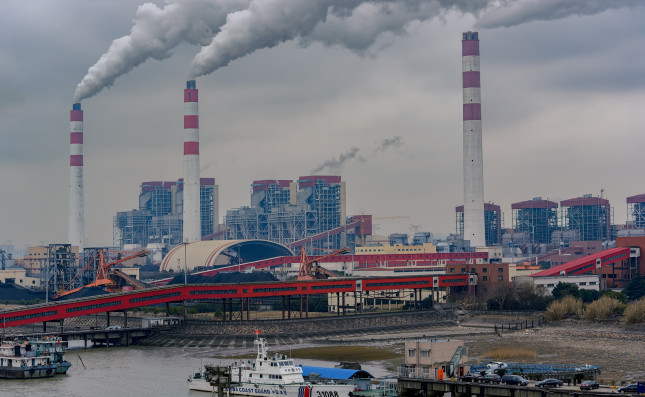-
Deep Determination: China’s Climate Commitments
As world leaders prepare to gather for the November UN climate change summit in Glasgow, all eyes are on China. As the world’s largest emitter of greenhouse gases, the emission reduction commitments China makes in its second Nationally Determined Contribution (NDC)—a country’s stated climate goals under the Paris Agreement—will provide direction for domestic climate actions and inform international climate cooperation efforts. In a recent Green Development Program report, we examine how China performed under its 2015 NDC and reflect on the targets and supporting policies we might expect to see in its second NDC. The good news? We see huge potential for China to go bigger and bolder in its climate action.
Digging Deep into Decarbonization
Through our research, we found that the majority of China’s 15 quantitative targets in the 2015 NDC have seen good progress, with nine achieving their 2020 target ahead of schedule. For example, carbon intensity in 2019 dropped 48.1 percent from the 2005 level, surpassing the 45 percent goal. The 2020 targets were in some cases outpaced—China’s installed capacity photovoltaic and wind power reached 204 million kilowatts and 210 million kilowatts, respectively, by 2019.
China has provided an indication of what is likely to appear in its new NDC. In September 2020 President Xi Jinping announced China’s 30/60 goal to achieve peak CO2 emissions by 2030 and hit carbon neutrality by 2060. Three months later Xi announced new 2030 climate targets at the Climate Action Summit, increasing goals for limiting carbon emissions and for wind and solar power generating capacity to reach 1,200 GW by 2030. Massive tree planting over the past three decades has improved the carbon sink intensity of China’s land ecosystem and Xi’s administration wants to build on this by expanding forest volume by 6 billion cubic meters by 2030 over 2005 levels, an increase of about 45 percent.
Xi’s administration has established a task force that is formulating a timetable and roadmap to achieve its climate goals. In the run up to Glasgow, China will unveil a clean and low-carbon energy transformation plan detailing how it will achieve the 30/60 goals. As the top emitter of short-lived climate pollutants, like methane and HFCs, it is encouraging that non-CO2 emissions will also be part of China’s climate plans.
Deep Enough?
At the general session of the 75th session of the UN General Assembly in September 2020, President Xi declared that “China will increase its NDC and adopt more powerful policies and measures.” The question now is whether China’s second NDC will be as ambitious as is possible.
China’s new 2030 carbon intensity reduction target of over 65 percent from a 2005 baseline is more aggressive than the 2015 NDC’s 60-65 percent reduction target, but many experts had recommended higher reductions.
There are ongoing concerns about China’s ongoing domestic build-out of coal-fired power generation and steel. The recent rebound of these sectors comes after several years of the government’s war on air pollution campaign that closed many coal plants. China’s significant investment in coal power outside its borders is also troubling, but it is showing signs of decreasing, and President Xi recently announced that the country would “not build new coal-power projects abroad.” A power sector development plan, expected by early 2022, will tell us more about the prospects for China’s domestic energy transition in the near term.
Most research findings agree that with full implementation of current emission reduction policies, China is likely to meet carbon peak and carbon intensity goals before 2030. But to help the planet meet the 2°C goal, China will need to cut emissions more quickly after 2030.
Roadmap to Ignite Stronger Subnational Climate Action
As we argue in our report, China’s second NDC is an opportunity to present a strong vision and a long-term global greenhouse gas (GHG) emission reduction roadmap. The roadmap has the potential to create a stable and consistent institutional framework to manage GHG goals, actions, and policies. The sectoral and provincial five-year plans that come out later this year and early 2022 could then work off of the goals in this framework to determine near-term actions.
There are many sectoral strategic plans that already contain robust, longer-term, energy-saving carbon reduction targets that could be incorporated into China’s second NDC. In the Energy Production and Consumption Revolution Plan 2016-2030, the non-fossil energy share is anticipated to increase above 50 percent of total energy consumption by 2050. The groundbreaking National Green and High Efficiency Cooling Plan issued in mid-June 2021 sets a 2030 goal of increasing the energy efficiency levels of cooling products by at least 25 percent. And the Mid- and Long-Term Strategic Plan for the Automobile Industry sets ambitious goals for new energy vehicles and increased fuel economy efficiency in all vehicles.
With the setting of 30/60 carbon goals, different regions, industries, and companies are already actively developing carbon peaking action plans and performing carbon neutrality research. Nineteen provinces and municipalities proposed carbon-peaking and carbon-neutrality action plans by April 2021. Steel, non-ferrous metal and other industry associations have started exploring carbon peaking and reduction. These local-level and sectoral climate actions can also be incorporated into the second NDC.
Go Big and Bold
China’s commitment to peak GHG emissions around 2030 have so far focused on energy-related CO2, not other GHGs. Meaningful actions of non-CO2 GHG emission reductions—which China’s climate envoy Xie Zhenhua recently suggested will be a part of China’s climate plans—would also give China’s second NDC more heft. As the Green Development Program argued in a recent op-ed, there are multiple policy options for non-CO2 GHG emissions reduction targets, including a non-CO2 emissions peaking target, a total HFCs emission reduction target, and sector-specific methane emissions reduction targets. Such targets would help create a long-term emission reduction vision encompassing all GHGs and all economic sectors.
China has a big opportunity to show bold climate leadership in its second NDC. It will not be a panacea, of course—significant challenges will remain as China continues to balance developmental and environmental goals. However, a robust document that hits key notes could unleash more subnational action within China and inspire other global actors to also up their game.
Diego Montero is Strategy Director at IGDP, where he works at the intersection of research, communications and strategic planning. He previously worked at Energy Foundation China. He holds a BA in Political Science from UC Berkeley and an MPP from Harvard Kennedy School.
Meian Chen is a Senior Analyst at IGDP. She focuses on global climate policy and China’s environmental governance. She holds a Ph.D. in Political Science from the University of Oregon and an MPP from Oregon State University.
Sources: CGTN, Chinadialogue, CNBC, en.people.cn, Global Times, iGDP, Nature, SCMP, UNFCCC, Yale360
Lead Photo Credit: Chinese Coast Guard vessel berthed at Shanghai pier next to one of China’s biggest coal-fired power plants Igor Grochev/Shutterstock.com.
Topics: China Environment Forum
 A Publication of the Stimson Center.
A Publication of the Stimson Center.








